A walk through the National Museum
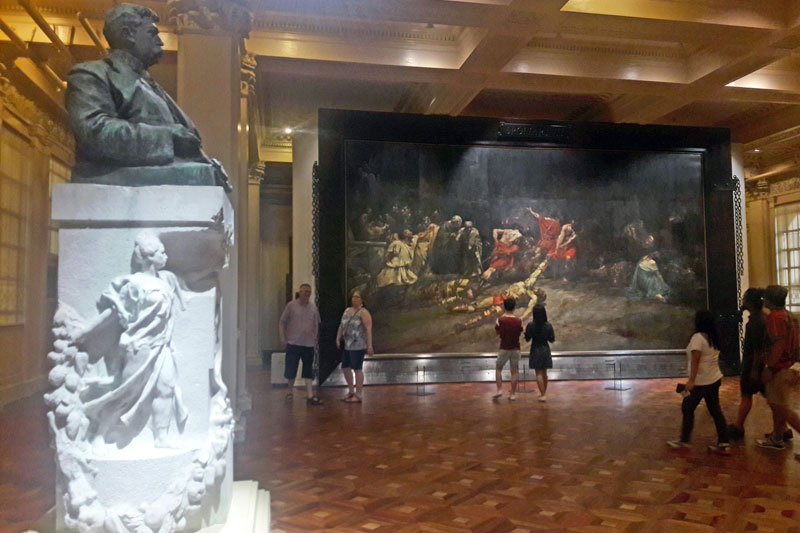
Juan Luna’s Spoliarium is perhaps the most popular – and the most photographed – piece in the National Museum’s collection. Eugene Bacasmas
MANILA, Philippines — There’s something poetic about the fact that the National Museum is located in the structures that once were the Finance and the Old Legislative buildings (with its third structure in the complex, the National Museum of Natural History to be housed in the former Department of Tourism building, set to open to the public in May this year).
After bearing witness to political change, war and destruction, and being raised again, these spaces now hold treasures beyond measure – artefacts of our collective history and culture as Filipinos.
The main lobby of the Museum of the Filipino People, which houses the anthropological and archeological collections of the National Museum, has colorful stained glass windows that still bear the emblem of the Department of Finance. Catching the midday sunlight, the surprisingly bustling weekend crowd is colored in reds and golds as they enter the museum.
Built in 1940 by Antonio Toledo under the Americans, the building’s design and location is influenced by the city plan of Daniel Burnham.
The Finance building was only one of the many government edifices in the city plan, but was also one of the few that was actually built, before the war interrupted the American developments in the country.
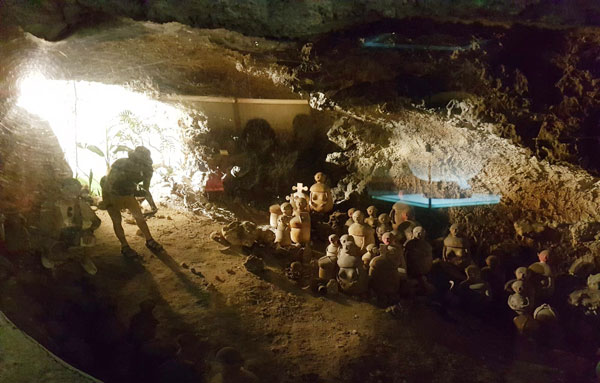
A burial jar and diorama depicting their discovery.
During the war, units of the Japanese Imperial Army holed up in the Finance building and the buildings were heavily shelled by the Americans. It was the recapture of the Finance building on March 3, 1945 that marked the end of the battle for Manila.
Later on, in 1998, the building was refurbished to house the National Museum of the Filipino People, in time for the centennial of the Philippine declaration of independence.
Today, the collection can be viewed mainly on three floors, with offices occupying the majority of the first floor.
Visitors can view the Treasures of the San Diego and other exhibits on maritime trade, the development of Baybayin and ancient burial rituals.
Highlights are the Manlilikha ng Bayan (National Living Treasure) gallery where I was pleased to see the feature on T’boli t’nalak dreamweaver Lang Dulay, who I was able to meet and talk to three times before her passing in 2015.
The Museum of the Filipino People is a smorgasbord of galleries, mostly about precolonial culture and history. At the same time, indigenous cultures on display are not only traditional parts of the past, but arts that are still being practiced today. The museum, then, becomes a repository not just of ancient history, but of living, breathing indigenous culture and arts that we must keep alive in the memory and consciousness of our people.
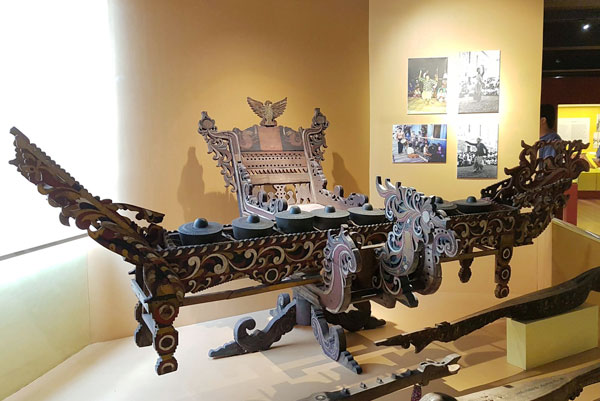
Elaborately decorated musical instruments are part of the display on Bangsamoro culture.
A short walk away from the Finance building is the Old Legislative Building, where visitors will find the National Art Gallery, which displays what can be considered the Western definition of visual art.
The building was originally designed as a public library and construction started in 1918 but stopped several times due to lack of funds. It was finally inaugurated in 1926 as the Legislature building. It is where the Constitutional Convention of 1934 was held, has been the venue for the oath-taking of several presidents, was the prime minister’s headquarters during Martial Law in 1972, was used for various government offices, before it was appropriated for the National Museum collection in 1998.
While lining up to register at the main lobby, one can already catch a glimpse of the obra of Juan Luna – arguably the most popular piece that the museum has on display – the Spoliarium, which accosts visitors with its sheer size as they enter the gallery.
Definitely one of the most photographed spots in the museum, I overhear one young visitor telling his friend (as they take a selfie) – “Ito ’yung sa Heneral Luna (This is the one in Heneral Luna),” referring to the scene in the blockbuster film that alludes to the painting.
Heneral Luna director Jerrold Tarog confirms that he did visit the National Museum to view the Spoliarium before filming the now iconic scene – “for inspiration and to get a sense of legacy – the idea that what you’re doing is connected to something larger.”
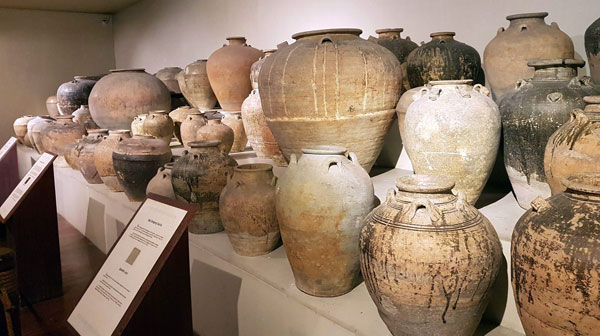
Artifacts salvaged from the San Diego include numerous jars of varied sizes.
Indeed, the Spoliarium – and other works in the museum – have this effect. You realize that as a Filipino, there is such a deep well of arts and culture that you can draw from – from the National Artists to the Manlilikha ng Bayan.
Another notable exhibit at the National Museum of Fine Arts is the Gallery of “Los Dos Pintores,” featuring the works and workspaces – and bromance – of Juan Luna and Felix Hidalgo.
Another gallery honors Jose Rizal, bringing together not only portraits and busts of his likeness, but also the hero’s own sketches and sculptures, giving us a glimpse of the National Hero as artist.
The exhibits on Colonial Tradition of Sacred Art and Via Cruces of an Unknown Bohol Master make an interesting juxtaposition with the indigenous rituals chronicled in the Museum of the Filipino People.
Another noteworthy parallel are the sarimanok motifs in Bangsamoro art displayed in the museum and the bronze interpretation of the same motif by National Artist Abdulmari Imao.
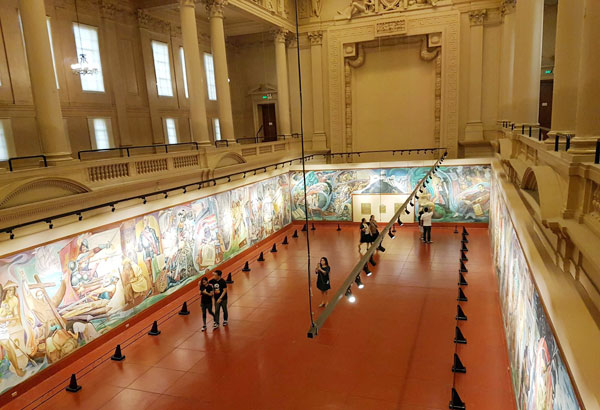
National Artist Botong Francisco’s “Filipino Struggles through History” in the old Senate session hall
“When we donated one of dad’s big brass sarimanok sculptures on the feast of the end of Ramadan some few years back, we were confident that the current administrators of the National Museum will put it in a special place – and they did,” says the late National Artist’s son Toym Imao, who is also an artist and an award-winning production designer for both stage and screen. “I believe a lot of collectors and institutions share the same confidence when they decided to donate, entrust or loan their priceless works of art to the museum – just look what they have achieved in less than a decade in terms of the refurbished spaces and exhibition halls.”
Toym recalls he first visited the National Museum in the late 70’s, when he was in third grade. “I remember the visual overdose and how cramped the place was. But I walked out with a sense of amazement and pride of country.”
As a visual arts professor, Toym makes it a point to bring his students to the museum regularly. “I bring my new batch of second year students every new school year to the National Museum of Fine Arts. I never grow tired of revisiting the place because I bear witness to its growth via new works put on display and new sections being opened to the public on thematic works of art,” he says.
Highlighting the importance of going to museums, Toym says, “I always tell my students that there is no substitute for experiencing a work of art in person, to come face to face with a work they would usually find in textbooks or images generated with an image search on the net. There is a sense of a form of homage every time you go out of your way to appreciate an important work by a master, to actually see the texture and strokes of the images makes it breathe with the pulse of the artists who have authored the work.”
He adds, “Encouraging young viewers to see the works contained in the museum will give them a sense of worth and depth of appreciation that their history and culture have. They will form part of a collective memory of our sense of excellence in the artistic field.”?
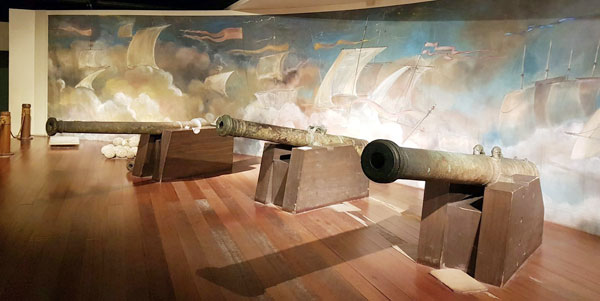
Canons from the Treasures of San Diego exhibit
On his most recent visit, Toym found his new favorite piece in the museum – a newly-installed mural spanning three walls of the the Old Session Hall of the Senate of the Philippines. Painted by National Artist Carlos “Botong” Francisco, the piece is the artist’s last and most monumental work, having been completed in 1968, less than a year before his death.
Commissioned by Antonio Villegas – Manila mayor from 1962 to 1971 – the mural once graced Manila City Hall. The subject of the mural is as massive as its scale – from precolonial times to the Spanish and American colonizations, independence and modernity. It is titled “History of Manila,” but is better known by another name: “Filipino Struggles through History.”
“Nothing compares to that feeling of awe and amazement when you step into the old session hall and you are greeted by the panoramic expanse of Botong Francisco’s epic work which used to hang in the ceremonial hall of the Manila City Hall,” says Toym. “Viewing it in person, you can better appreciate it and admire the colors, textures and composition of this magnum opus of maestro Francisco.”
He adds, “Now more than ever we should encourage real time encounters with the artistic and cultural wealth of our country. In this age of advanced technology it becomes so easy to conjure up beautiful objects and images with a few clicks of a button via the latest imaging software. Coming face to face with old school imaging via paintings and sculpture humanizes these artworks because one can experience the actual scale and nuances of the artist’s oeuvre when one is immersed by its tangible presence.”
Throughout my day exploring the two buildings of the National Museum (and anticipating the third addition to the complex, opening in May), I try to find a narrative thread that will inform how I should experience the numerous galleries and exhibits. And then, contemplating Botong Francisco’s mural, I realize that, perhaps, there is simply not one single narrative to be found. Rather, the National Museum houses a collection as varied as our nation’s history.
The National Museum shows us a collection of fragments – broken pieces of an ancient clay palayok with Baybayin lines etched on its surface, waiting to be interpreted; multi-colored threads from all over the country, waiting to be strung on the loom.
In these various galleries, different things will speak to different Filipinos – inspiring filmmakers, artists, teachers, students.
Whether it be through a colorful sarimanok in one gallery, morphing into a bronze bird in another; displays of ritual anting-anting and burial jars in one gallery and Catholic icons in the next; or a mural that maps the entire history of the struggles of our people from prehistory to modernity, the National Museum is a disparate amalgamation of what it means to be a Filipino.
* * *
The National Museum of the Filipino People and the National Gallery of Fine Arts are open to the public Tuesdays to Sundays, 10 a.m. to 5 p.m. Admission is free. For more information, visit www.nationalmuseum.gov.ph
- Latest
- Trending













